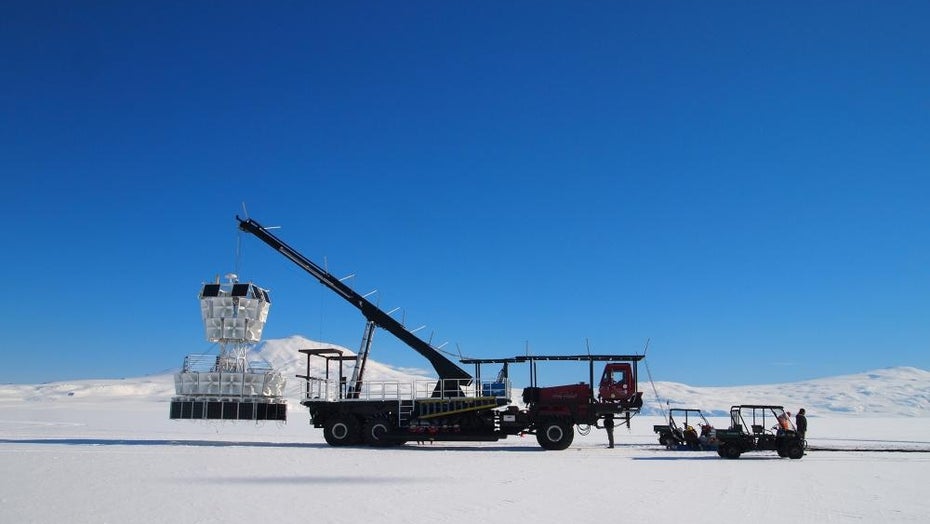In the vast, desolate expanse of Antarctica, an international team of researchers has stumbled upon a profound scientific puzzle. They have detected mysterious radio signals that appear to defy our current understanding of particle physics. This unprecedented observation challenges long-held scientific models.
It forces scientists to consider the possibility of entirely new phenomena or even previously undetected forms of matter, such as dark matter. The intriguing signals were picked up by a specialized instrument designed for a different purpose altogether. Now, the scientific community is eagerly anticipating the deployment of a new, more advanced detector. This next-generation instrument aims to shed light on this puzzling cosmic mystery. The discovery has ignited excitement and debate across the globe among physicists and astronomers.
The ANITA Experiment: Listening for Ghost Particles
The anomalous signals were intercepted by the Antarctic Impulsive Transient Antenna (ANITA). This unique experiment was designed with a specific, yet different, cosmic quest in mind.
Mission: Hunting for Ultra-High Energy Neutrinos
Researchers primarily utilize ANITA in their search for ultra-high energy neutrinos. These elusive subatomic particles are often referred to as “ghost particles” because they rarely interact with normal matter. Neutrinos can travel vast cosmic distances unimpeded, carrying vital clues about some of the universe’s most violent and energetic events.
Detecting them can provide unprecedented insights into distant supernovae, powerful exploding stars, or the chaotic environments around supermassive black holes. These cosmic accelerators are believed to be the birthplaces of such high-energy particles. By studying these neutrinos, scientists hope to unravel the mysteries of the most extreme corners of our universe. They could reveal processes that shape galaxies and determine the fate of massive stars.
How ANITA Works: A Balloon-Borne Listener
ANITA is not a ground-based observatory. Instead, it operates as a balloon-borne antenna array. This sophisticated instrument floats at an impressive altitude of approximately 40 kilometers (about 25 miles) above the icy surface of Antarctica. From this vantage point high in the stratosphere, ANITA listens for faint radio waves. These radio waves are generated when ultra-high energy neutrinos, upon entering Earth from space, interact with the dense ice sheets below.
This phenomenon is known as the Askaryan effect. When a high-energy neutrino collides with an atom within the ice, it produces a cascade of charged particles. These particles then travel faster than the speed of light in ice, emitting a characteristic cone of radio waves, much like a supersonic jet creates a sonic boom. ANITA’s array of antennas is specifically designed to detect these subtle radio pulses.
Why Antarctica? An Ideal Cosmic Laboratory
Antarctica provides an exceptionally ideal environment for ANITA’s mission. The continent’s massive, pure ice sheet serves as a perfect target for neutrino interactions, acting as a giant detector medium. The extremely cold and dry air at ANITA’s operating altitude ensures minimal atmospheric interference. Furthermore, Antarctica’s remote location means there is very little terrestrial radio noise.
This creates an incredibly quiet electromagnetic environment. This pristine background allows ANITA to pick up the extremely faint, transient radio signals from cosmic neutrinos without significant interference from human activity. The clear, stable atmosphere above the continent also provides consistent conditions for balloon operations, allowing for long-duration flights crucial for collecting sufficient data.
An Unprecedented Anomaly: Signals Defying Physics
Despite ANITA’s primary mission, a research team led by Astrophysicist Stephanie Wissel from Pennsylvania State University encountered something entirely unexpected: a perplexing radio signal that fundamentally challenges established scientific understanding.
The Discovery of an Impossible Signal
The team, while analyzing data from ANITA, discovered a set of unusual radio signals. These signals appeared to originate from a direction that directly contradicts the current scientific consensus. Specifically, these radio waves were detected coming from “really steep angles,” approximately 30 degrees below the surface of the ice.
This directional origin presents a profound paradox. According to the established Standard Model of particle physics, a signal originating from such a steep downward angle and traveling through thousands of kilometers of dense Earth material should simply not be detectable in this manner. It suggests a particle with properties that allow it to traverse immense distances through matter without significant interaction.
The Paradox of Deep Earth Penetration
The implication of a signal coming from 30 degrees below the ice surface is immense. It means that the particle responsible for generating these radio waves must have traveled thousands of kilometers through solid rock—the Earth’s crust and mantle—before emerging to interact with the Antarctic ice. This deep penetration is the crux of the anomaly.
Standard Model particles, especially high-energy ones capable of generating such signals, would inevitably be absorbed or significantly attenuated by such a vast amount of dense matter. Their interaction cross-sections, which describe the probability of them colliding with other particles, are simply too high for them to pass through the Earth unscathed. The detection of these “up-going” signals, apparently coming up through the Earth, therefore presents a direct challenge to the Standard Model’s predictions about how particles interact with matter.
Why It’s Not a Neutrino: The Absorption Problem
Given ANITA’s primary mission, the most intuitive explanation for a radio signal from ice is a neutrino. However, the unique angle of these detected signals quickly ruled out neutrinos as the source. Neutrinos, despite their “ghostly” nature, would have been absorbed by the vast amount of rock they would have had to traverse if originating from below the ice surface. While neutrinos interact weakly, their interaction probability increases with energy and the amount of material they pass through.
A neutrino with enough energy to create a detectable radio signal after traversing thousands of kilometers of rock would almost certainly have interacted long before reaching the ANITA detector. Therefore, the researchers unequivocally state that these signals are “anomalous.” Stephanie Wissel herself confirmed that, “Most likely, it is certainly not neutrinos.” This leaves a gaping hole in conventional explanations, compelling scientists to look beyond the known particles.
Exploring Hypotheses: Dark Matter and Unknown Effects
With standard explanations dismissed, the scientific community is now grappling with more speculative, yet exciting, possibilities for the origin of these inexplicable signals.
The Allure and Challenge of Dark Matter
One tantalizing hypothesis that quickly emerged was the possibility of dark matter. Dark matter is a mysterious, invisible substance believed to constitute about 27% of the universe’s mass. It does not interact with light or other electromagnetic radiation, which is why it’s “dark.”
However, some theoretical models propose that certain types of dark matter particles, particularly Weakly Interacting Massive Particles (WIMPs), could occasionally interact very weakly with normal matter, producing other particles that could then generate radio signals. If these anomalous ANITA signals were indeed caused by dark matter interactions, it would represent a groundbreaking discovery, confirming the existence of this elusive substance and potentially ushering in a new era of physics.
However, this exciting possibility faces significant challenges. A comparison with data from other major neutrino and cosmic ray detectors, specifically IceCube and the Pierre Auger Observatory, yielded no comparable signals. IceCube, a cubic kilometer of ice instrumented with sensors deep beneath the South Pole, is designed to detect high-energy neutrinos and potentially dark matter interactions. The Pierre Auger Observatory in Argentina studies ultra-high energy cosmic rays.
The absence of similar anomalous signals from these detectors casts doubt on the dark matter hypothesis as the sole explanation for the ANITA anomaly. If a particular type of dark matter were interacting in a way that produced these signals, it might be expected to show up in other detectors designed to observe high-energy cosmic phenomena, or at least in a broader range of energies or interaction types. This lack of corroboration suggests that if it is dark matter, it must be a very specific, unique type of interaction or particle, or that the ANITA signals have another, perhaps more mundane, explanation.
Stephanie Wissel’s Alternative: A New Radio Propagation Effect
Facing the inconsistencies with existing dark matter theories and standard particle physics, Stephanie Wissel proposes an alternative explanation. She suggests that the signals could be the result of a previously unknown effect related to the propagation of radio signals. This effect might specifically occur under certain unique environmental conditions, such as in the presence of large ice masses and when signals are traveling near the horizon.
This hypothesis suggests that the physics of radio wave behavior itself, under extreme conditions, might be more complex than currently understood. For instance, peculiar atmospheric layering or specific ice properties could potentially refract or guide radio waves in unexpected ways, allowing them to appear to originate from below the surface when they actually traveled a more circuitous path.
At this moment, the origin of these signals remains one of the many perplexing “secrets” in astrophysics. Wissel candidly admits that finding a definitive solution “could take years.” The process involves meticulous analysis of existing data, development of new theoretical models, and crucially, the design and deployment of new experimental instruments.
Their findings, detailing the anomalous signals and their implications, have been published in the respected academic journal Physical Review Journal, ensuring peer review and fostering widespread scientific discussion. This publication serves as an open invitation to the global physics community to contribute to solving this intriguing puzzle.
The Standard Model Under Scrutiny: Implications for Physics
The ANITA signals directly challenge the Standard Model of particle physics, which describes the fundamental forces and particles that make up the universe.
The Blueprint of Reality Challenged
The Standard Model is the most successful theory in particle physics. It accurately describes three of the four fundamental forces of nature (strong, weak, and electromagnetic) and classifies all known elementary particles. It is the blueprint of how we understand matter and energy at the smallest scales. The ANITA signals, if confirmed to be from a particle traversing the Earth in an unpredicted way, imply that there could be new particles or new interactions not accounted for in this model.
Specifically, the “up-going” nature of the anomalous signals suggests the presence of a particle with a much lower interaction cross-section than any known Standard Model particle. Such a particle would be incredibly light and interact only very, very weakly with other matter. If it were a neutrino, as discussed, it would have been absorbed. This contradiction points to either a flaw in our understanding of known particles’ interactions or the existence of a particle beyond the Standard Model.
Searching for Beyond-Standard-Model Physics
The possibility of a “beyond-Standard-Model” (BSM) particle is what truly excites physicists. Discoveries like these are exceedingly rare and could lead to a revolution in fundamental physics, similar to how the discovery of the neutrino itself opened new avenues of research. The ANITA anomaly provides an empirical hint that our current understanding of the universe is incomplete.
It motivates the search for new theoretical frameworks and prompts experimental physicists to design instruments capable of detecting these hypothetical BSM particles. This ongoing quest for new physics could help explain other cosmological mysteries, such as the nature of dark matter and dark energy, which the Standard Model currently cannot account for.
The Global Scientific Context: Comparing with Other Detectors
The lack of corroboration from other major observatories is a critical piece of the puzzle, influencing how scientists interpret the ANITA anomaly.
IceCube and Pierre Auger: Different Lenses on the Cosmos
The fact that similar signals have not been detected by IceCube and the Pierre Auger Observatory is highly significant. IceCube, embedded deep within the South Pole ice, is primarily a neutrino telescope. It uses a vast array of optical sensors to detect the faint light produced when neutrinos interact with the ice. While it primarily looks for neutrinos coming through the Earth, its detection method and energy thresholds are different from ANITA’s.
If the ANITA anomaly was a general phenomenon related to neutrino interactions or a widely interacting dark matter particle, IceCube might be expected to see something similar.
Similarly, the Pierre Auger Observatory in Argentina is the world’s largest cosmic ray observatory. It detects ultra-high energy cosmic rays by observing the extensive air showers they produce when they strike Earth’s atmosphere. Its primary focus is on particles with much higher energies than those typically associated with ANITA’s radio detections.
The non-detection by these complementary instruments suggests that the ANITA anomaly might be very specific to the unique conditions of its experiment (e.g., its high altitude, its specific interaction with ice, or its sensitivity to a particular energy range or type of particle not efficiently detected by IceCube or Auger). This distinction pushes researchers to think about very niche physical phenomena or particles with extremely peculiar interaction properties.
The Importance of Independent Verification
In science, independent verification is paramount. The absence of similar signals from other detectors means that the ANITA observations, while intriguing, currently stand alone. This doesn’t invalidate ANITA’s findings, but it means the burden of proof for a revolutionary discovery falls heavily on subsequent experiments.
Scientists must either find a new theoretical model that precisely explains why ANITA sees these signals while others don’t, or build new instruments specifically designed to confirm and further characterize these anomalies. This highlights the painstaking process of scientific discovery, where extraordinary claims require extraordinary evidence, often obtained through multiple, independent observational efforts.
The Path Forward: PUEO and Future Discoveries
To gain more clarity on this anomalous signal and potentially solve one of science’s most intriguing mysteries, a new, dedicated detector is currently under development.
Introducing PUEO: A Next-Generation Detector
The scientific community is not content to simply ponder the mystery. A new, advanced detector, known as PUEO (Payload for Ultrahigh Energy Observations), is being developed at the Pennsylvania State University, precisely where Stephanie Wissel’s team is based. PUEO is designed to be a direct successor and significant upgrade to ANITA.
This new facility will be larger than ANITA, implying it will carry more and potentially more sensitive antennas, allowing for a wider field of view and enhanced detection capabilities. The increased scale and improved instrumentation are intended to gather more comprehensive data, providing clearer insights into the nature of the enigmatic signals.
Enhanced Neutrino Detection and Anomaly Investigation
PUEO’s primary mission will still include the search for ultra-high energy neutrinos, and it is expected to be “even better in the recognition of neutrino signals.” This improved sensitivity will allow it to detect a broader range of neutrino interactions with greater precision, furthering our understanding of cosmic accelerators.
Crucially, however, PUEO is also being specifically designed to investigate the ANITA anomalies. Its enhanced capabilities will allow researchers to either confirm the existence of these anomalous signals with higher statistical significance or rule them out by showing they were perhaps a fluke or a terrestrial interference not fully understood. If confirmed, PUEO’s design will enable scientists to gather more detailed information about the properties of the particles causing these signals, helping to distinguish between a new propagation effect, a new particle, or even the subtle interactions of dark matter.
The Long Road to Discovery
The solution to these “secrets” may still take “years” to unravel, as Stephanie Wissel suggests. The development, deployment, and data analysis from PUEO represent a significant long-term scientific endeavor. However, the prospect of a breakthrough – whether it reveals a fundamental crack in the Standard Model, points to the elusive nature of dark matter, or uncovers a previously unknown quirk of physics – fuels the tireless efforts of these researchers.
The Antarctic radio signals serve as a powerful reminder that even in an age of advanced scientific knowledge, the universe continues to hold profound mysteries, waiting to be discovered by those brave enough to listen to its faintest whispers. The scientific pursuit is an ongoing journey of observation, hypothesis, rigorous testing, and continuous learning, pushing the boundaries of human understanding into the unknown.








